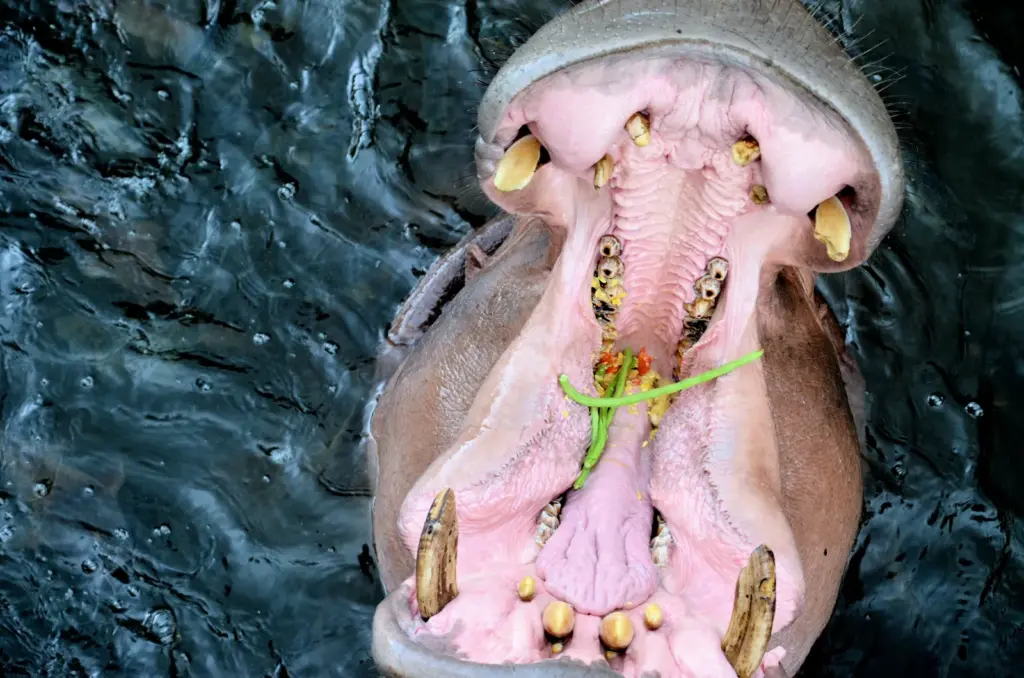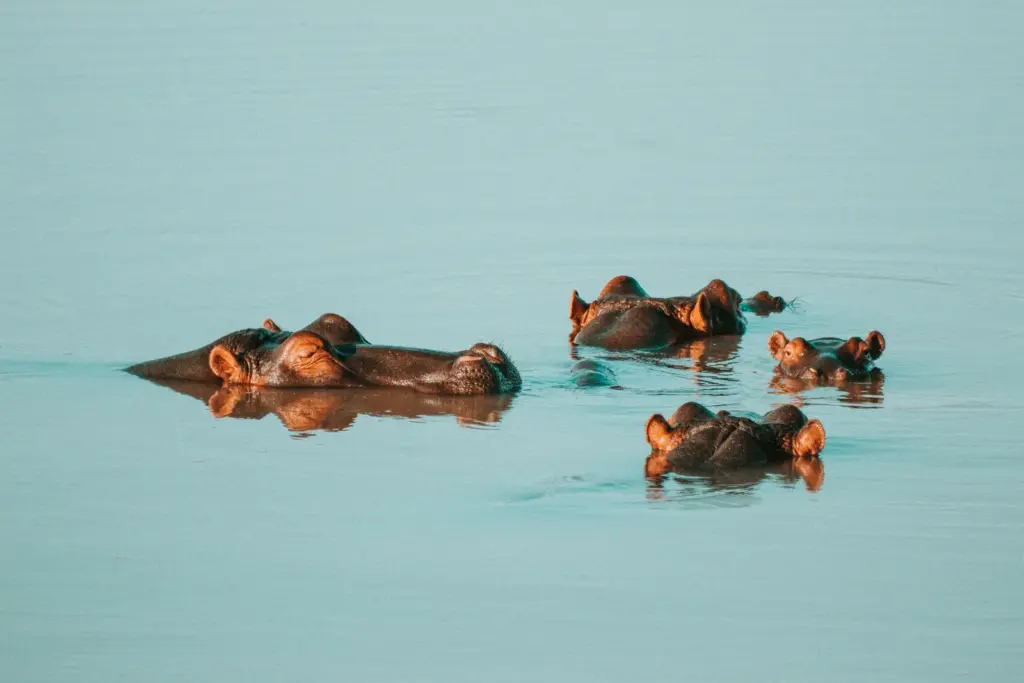Hippos primarily consume short grasses, such as Cynodon and Panicum, consuming 25-40 kg nightly, using their broad, horny lips to grasp vegetation.
Their feeding occurs mainly during cooler nighttime hours to avoid daytime heat. Although they are primarily herbivorous, rare instances of omnivorous behaviour, including scavenging on animal carcasses, have been observed.
Baby hippos rely on their mother’s milk at birth but shift to grass around three weeks old. Hippos greatly impact their environment by creating “hippo lawns” and altering soil composition. Further insights are available to uncover more fascinating aspects of their dietary habits and ecological roles.
Main Takeaways
- Diet: Hippos primarily eat short grasses like Cynodon and Panicum, consuming 25-40 kg of grass every night.
- Feeding Behavior: Hippos are nocturnal grazers, feeding for 5-6 hours each night, creating “hippo lawns”.
- Occasional Omnivory: Although mainly herbivorous, hippos occasionally scavenge animal carcasses, sometimes engaging in cannibalism.
- Baby Hippo Nutrition: Calves initially rely on their mother’s milk, starting to graze on grass around three weeks old.
- Teeth and Jaw Strength: Hippos have strong jaws (bite force of 1800 psi) and sharp teeth, which they use for defence, not just feeding.
- Environmental Impact: Hippo waste enriches aquatic ecosystems but can lead to problems like algal blooms when rivers are stagnant.
- Human Impact: Climate change, habitat encroachment, and human developments disrupt hippo habitats and affect their food sources.

Hippo Dietary Preferences
Hippos are mainly herbivorous creatures. Their dietary preferences revolve around consuming short grasses like Cynodon, Panicum, and Heteropogon. These grasses form the main part of their feeding.
Hippos consume approximately 25-40 kg (55-88 lbs) of vegetation nightly, which amounts to about 1-1.5% of their body weight.
The feeding of hippos is characterized by their preference for tender vegetation over coarse, tussock-forming grasses. Using their broad, horny lips, they can grasp and tear grass, while their jaws, capable of opening to 180 degrees, are a powerful chewing system.
Despite their classification as mainly herbivorous, hippos exhibit rare omnivorous behaviour. On infrequent occasions, they have been observed scavenging on animal carcasses, although this is not a significant component of their diet.
Feeding Behavior
Hippos are nocturnal grazers, dedicating 5-6 hours each night to eating. Their diet largely consists of short grasses, from which they derive nutrients.
Despite their size, hippos consume a relatively modest amount of vegetation—approximately 25-40 kilograms per night, accounting for about 1-1.5% of their body weight.
Their feeding behaviour is characterized by creating “hippo lawns,” areas of extensively grazed short grasses, resulting from their consistent grazing habits. These lawns can have significant ecological impacts, shaping the vegetation patterns and influencing the biodiversity of the ecosystems they inhabit.

In search of food, hippos follow established grazing paths, sometimes travelling up to 5 kilometres from their water sources. This movement guarantees they can access the necessary nutrients while maintaining a connection to the water, essential for their survival and overall well-being.
Occasional Meat Consumption
While hippos are mainly herbivorous, occasional meat consumption, primarily through scavenging, has been documented. Although rare, this habit is a fascinating aspect of the hippos’ diet.
Hippos occasionally eat meat by scavenging on carcasses, such as those of crocodiles. This behaviour suggests opportunistic feeding that deviates from their typical plant-based diet. The omnivorous behaviour observed in hippos is thought to arise from nutritional deficiencies or environmental stressors that limit access to their usual food sources.
Hippos Cannibalism
The hippopotamus’s diet is marked by an intriguing and sometimes controversial facet: the occasional consumption of animal matter, including instances of cannibalism.
While cannibalism is generally rare, it’s not absent, and hippos are no exception. However, it is essential to note that this behaviour has a significant downside: the high risk of spreading infectious diseases.
Geophagy: Do Hippos Eat Dirt?
Geophagy, observed in various animals worldwide, is the deliberate ingestion of dirt, mud, or small rocks.
For hippos, the answer to this question is No! Hippos do not eat soil to integrate their diet. However, they roll in the mud and use it as a sunscreen.
Interaction with Other Animals: Symbiotic Relationships
While the hippopotamus leads a largely solitary existence in terms of its dietary habits, it isn’t entirely isolated from the interconnected web of the animal kingdom.
Hippos often engage in symbiotic relationships with other animals, particularly birds. While not directly related to the food hippos consume, these mutualistic interactions are important to their health and well-being.
One of the most iconic images of hippos is their lounging in the water, with birds perched atop their bodies. As they peck away, these birds remove ticks, dead skin, and other parasites in the Hippo’s thick hide.
The Hippo provides a moving feast for the birds. In return, the Hippo thoroughly cleans, relieving the irritation and potential diseases these parasites might cause.

Hippos – The Importance of Teeth For Feeding
Hippopotamuses possess 36 teeth, made up of 8 incisors, four canines, 12 premolars, and 12 molars. Interestingly, some hippos might have an extra count of teeth as certain deciduous or ‘baby’ teeth can stay into adulthood.
They have flat-ridged molars and premolars, which are used primarily for grinding and crushing food. However, excessive grinding can lead to wear and tear, compromising their eating ability and potentially leading to malnourishment.
The Role of Incisors and Canine Teeth in Hippos
While most of their teeth serve dietary purposes, the incisors and canines of hippos have different functions. These teeth are primarily tools for fighting and self-defence against potential threats.
Their lower canines are very sharp, reaching lengths of approximately 50 cm. Meanwhile, their incisors can achieve up to 40 cm. The continuous grazing action of the hippos ensures these teeth remain sharp.
The Hippo’s jaw has an opening between 150 to 180 degrees. Hippos’ jaws have a bite strength of 1800 psi (pound per square inch); they overshadow the bite force of both lions (650 psi) and polar bears (1200 psi).
The lethal combination of the Hippo’s razor-sharp teeth and formidable jaw strength can easily crush bones and penetrate other animals when fighting.
Baby Hippo Nutrition
Newborn hippos, weighing approximately 40 kilograms at birth, require a substantial food intake to support their rapid growth. In infancy, calves rely heavily on their mother’s milk, which provides essential nutrients for development.
Remarkably, newborn hippos can suckle underwater, closing their eyes and nostrils to continue feeding while submerged.
The journey toward independence begins at three weeks when calves are introduced to solid food, primarily grass. This gradual incorporation of solid food into their diet complements the rich nutrition obtained from milk.
During this significant shift, suckling remains a key aspect of their diet, persisting for up to eight months.
As they begin grazing, baby hippos maintain proximity to their mothers for protection. Initially, they stay within a safe distance to explore their surroundings and practice grazing techniques.

Conflicts with Humans: Occasional Foraging on Cultivated Crops
As human populations expand and agricultural activities intensify, the boundaries between wild habitats and cultivated lands become increasingly thin.
This overlap can lead hippos to wander into farmlands searching for food. Crops such as maize, sugar cane, and other cultivated plants can be particularly enticing to them.
Environmental Impact on the Hippos’ Diet
As human populations expand and natural landscapes undergo transformation, the delicate balance of ecosystems is inevitably disrupted.
Like many other species, the hippopotamus is most affected by these changes, particularly in its dietary habits, sources, and general survival.
The survival of hippos is closely intertwined with the well-being of the ecosystems in which they reside. Threats to hippos due to climate change and human impacts could have a cascade of effects on the ecosystem.
- The Role of Hippo Waste in Ecosystem Dynamics: Hippos produce large quantities of waste rich in nutrients. In a natural environment, when rivers flow, these faeces get dispersed, providing nutrients to aquatic flora and fauna.
- Climate Change and Water Flow: As climate change leads to erratic rainfall patterns and prolonged droughts, the usual flow of rivers can be reduced. This event diminishes the natural dispersion of the hippos’ nutrient-rich waste, leading to localized build-ups.
- Human Developments: The construction of dams, diversions for irrigation, and other infrastructural developments can interrupt the natural flow of rivers. It affects the dispersion of hippo waste and disrupts the migratory patterns of other aquatic species.
- Nutrient Overload and Algal Blooms: In areas where hippo waste accumulates due to stagnant water, it can lead to eutrophication. In this process, water bodies receive an influx of nutrients, promoting excessive algae growth known as algal blooms. While algae are a natural part of aquatic ecosystems, an overabundance can lead to several ecological problems.
- Depletion of Oxygen: As these algal blooms die off, bacteria’s decomposition consumes oxygen from the water. This results in hypoxic (low oxygen) conditions, which can be lethal for most aquatic species, including fish, crustaceans, and aquatic plants.
- Ripple Effect on the Food Web: The death of aquatic species can disrupt the food chain. Predators that rely on these species for sustenance may starve, while scavengers might temporarily flourish. Over time, however, the overall health and diversity of the ecosystem can decline.
- Human Impacts: Beyond the direct interference in river flow, human activities such as pollution, habitat encroachment, and hunting can further jeopardize the hippo population, amplifying ecological consequences.
Conclusions
Primarily herbivorous, hippos feed on short grasses such as Cynodon and Panicum, consuming nightly 25-40 kg of vegetation.
Their feeding creates “hippo lawns,” which impact soil composition and local ecosystems. Although rare, hippos exhibit occasional omnivorous behaviour, including scavenging and cannibalism.
Baby hippos initially rely on their mother’s milk but begin grazing on grass within a few weeks. Hippos also engage in symbiotic relationships, particularly with birds, which aid in their health by removing parasites.
Climate change and human activities threaten hippo habitats and feeding patterns. These disruptions can have cascading effects on aquatic ecosystems, particularly by accumulating nutrient-rich hippo waste, which can lead to algal blooms and oxygen depletion. Preserving hippo habitats and ensuring sustainable ecosystem management is crucial for maintaining the balance of biodiversity.



